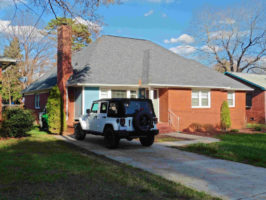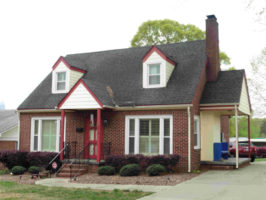1904 Patton Avenue
Built in 1952-53 for Hubert and Henrietta Norris who both taught for decades at Johnson C. Smith University. Hubert Norris specialized in economics and political science, while Henrietta Norris taught early childhood education.

Built in 1952-53 for Hubert and Henrietta Norris who both taught for decades at Johnson C. Smith University. Hubert Norris specialized in economics and political science, while Henrietta Norris taught early childhood education.

Built in 1958 for educators Lorenzo E. Poe and Dorothy Brewer Poe. Lorenzo Poe came to Mecklenburg County about 1937 to be the first principal of what is now the Ada Jenkins School in the town of Davidson, just north of Charlotte. He later served nineteen years as principal of Sterling High in Pineville, just south of Charlotte — its last leader prior to closing as part of Charlotte’s school integration. His wife Dorothy Brewer Poe also taught in the public schools.

Built 1964-65 by Romeo Alexander, well-known as the proprietor of Razades Restaurant on Statesville Avenue and an active investor in real estate.
In 2017 Romeo Alexander’s daughter-in-law Vi Lyles won election as Charlotte’s first female African American mayor.

First appeared in city directory in 1953, home of Rev. James R. Holloway and wife Christine H. Holloway, a nurse at Charlotte’s black good Samaritan Hospital. Rev. Holloway directed the Mecklenburg Baptist-Interracial Commission, working in partnership with white minister Rev. Claude Broach at St. John’s Baptist Church. It was a rare example of black-white interracial activism prior to the Supreme Court’s 1954 Brown v Board desegregation order.
Subsequent residents included Second Ward High School principal Spencer E. Durante in the late 1950s.

This house has been heavily remodeled in recent years. It may be the same house that first appeared in city directories as “2012” Patton Avenue in 1942-43. Emery Rann, Sr., a college professor at Johnson C. Smith University, lived there with his wife Vicie Rann. In 1952 the address was evidently renumbered as “2004.” Mrs. Rann, now a widow, continued to live there until her death in 1954.
There is currently no house numbered 2001 Patton Avenue, nor is there a vacant lot corresponding with that number. It is likely that the permit was taken out to construct 2001 Patton in 1961 but then construction did not take place.

Built in 1952, this was the longtime home of Dr. Emery L. Rann, Jr., (3.9.1914 – 9.15.1996), one of Charlotte’s most important physicians and civic leaders, and his wife Margratha.
Dr. Rann became a major force in the Civil Rights Movement’s drive to desegregate healthcare across North Carolina and he helped lead the NAACP’s nationwide campaign to open hospitals to all. He was also active in dozens of other arenas — from pushing for voting rights, to integrating the board of Central Piedmont Community College, to helping establish the Boulé (more formally known as Sigma Phi Phi fraternity) in the southeastern U.S. He was also a published poet who wrote the lyrics for the alma mater of Meharry Medical College.
When the black National Medical Association elected him President in 1973-74, his views were widely quoted in the national media. Ebony magazine named him one of 1974’s “100 Most Influential Black Americans.”

Built in 1960-61 for artist Ira Brewer, Jr., and his wife Arcasia Brewer. Mr. Brewer taught art in Charlotte-area schools for thirty-four years. Outside of work, he founded Los Bravos In 1976, a non-profit social and charitable organization — the men’s counterpart of the women’s club Las Amigas, Inc. (Las Amigas, which had been launched in Charlotte in 1957, boasted 22 affiliate clubs across the eastern U.S. in 2017; it is not known how many Los Bravos clubs exist).

This is among the oldest houses in McCrorey Heights and it has been much remodeled over the years. It may date back to the 1920s; when this block first appeared in city directories in 1931, a plasterer named Hazel Stewart and his wife Eunice were among the residents. Address numbers seem to have shifted over time, but by 1942 Hazel and Eunice Stewart were listed here at #2014. Later listings at this address showed David H. [Hazel?] Stewart as proprietor of David’s Plaster Contractors into the 1970s.

Built 1950-51 by the Presbyterian Church as residence for ministers, it housed two key pastors of Amay James Presbyterian Church on the city’s west side: Rev. Leon Anderson in the early 1950s and Rev. McKinley Alphonso Cochrane from the late 1950s into the 1970s.
Mecklenburg Presbytery took out the building permit on January 13, 1950.